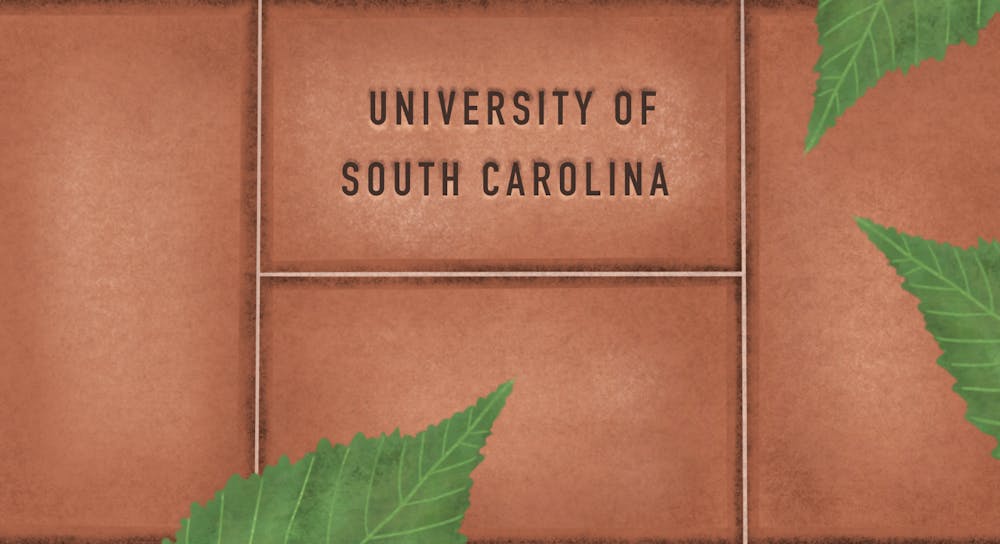Every student at the University of South Carolina walks through the Horseshoe at some point. Whether they’re studying or using the trees’ shade to take a break from the Columbia heat on the way to class, they’ve likely seen the brick-paved paths bearing the names of faculty and alumni.
Though students might pass over them without much thought, these bricks have a rich history at USC.
USC’s Horseshoe has grown famous for its tradition of alumni bricks, which were first constructed in 1931. English professor Havilah Babcock first struck up the effort to pave the Horseshoe with bricks in 1931.
At the time, the university had asked the state legislature to fund the project, but in the midst of the Great Depression, the legislature declined, making the project a student effort.
With the incentive to be excused from class, students gathered on the Horseshoe under the direction of local brick masons and laid the foundational "U" shape of the Horseshoe in just a few months.
“(It was) pretty remarkable,” Chris Horn, director of editorial projects at USC, said.
In an effort not only to recognize their work but also to honor the leaders of the project, the students laid white bricks of their initials to mark the work they had done. The Greek letters in white brick across the outer ‘U’ of the Horseshoe represent the student organizations that offered their service in the project.
Also around the outer rim of the Horseshoe are the initials "HB," for the notable English professor that initiated the project. The second set of initials, found in red brick, "MEE," mark the students’ admiration for their Black brick mason, who taught them how to lay the brick in a still-segregated South Carolina.
“We didn’t know why they were different, and then, many years ago, we ran an article on the brick sidewalk project for 1931 and one of the alumni who participated in it wrote us a letter and talked about working on that," university archivist Elizabeth West said. "He and his group were working up in that area and they liked their brick mason so much that they snuck his initials into the sidewalk. His name was Marion E. Evans.”
Since that initial brick pathway was laid, there have been multiple changes and additions to the Horseshoe. However, the names that can be seen on many of the pathways across the Horseshoe were not added until the university’s bicentennial project in 1995.
“In terms of being able to have an opportunity for alumni to have a permanent place on the university campus, I think (that) was really what started it," Elizabeth Muth, chief operating officer at the USC Alumni Association, said. "From there, the idea of the Horseshoe brick tradition, kind of, really took off.”
Muth said she believes the historic tradition of having students lay the bricks on the Horseshoe and listing their organizations in the brick might have started the idea for alumni to have a permanent spot with their name on the campus.
The Alumni Association's brick installations in the winter and summer adds around 100 new alumni bricks each to the thousands already layering the Horseshoe with the help of other university facilities, according to Muth.
While most of the bricks contain some messages from alumni, there are multiple bricks on the Horseshoe that are dedicated to students, faculty and staff that passed away during the previous year. There are bricks honoring University 101 instructors. There is even a marriage proposal inscribed on a brick on the Horseshoe.
The brick most famous to U101 students is the Hootie and the Blowfish brick. Other notable bricks are centered around the Maxcy Monument. This includes bricks dedicated to each university president that has served and those who have served in university leadership. There are also three bricks near the Maxcy Monument dedicated to each of the three students who desegregated the school in 1963, which were unveiled with a ceremony in 2015.
Muth said she believes each of these bricks — comprised of three lines, with 14 characters per line — has a story connected to a person who has memories at this university. She said she sees this as a special way for alumni to reflect on their time here.
“The uniqueness of the opportunity to have a permanent place on the university campus — that doesn’t happen at every university," Muth said. "Being able to purchase a piece of that history and being a part of that tradition is something really special and unique for our alumni.”

